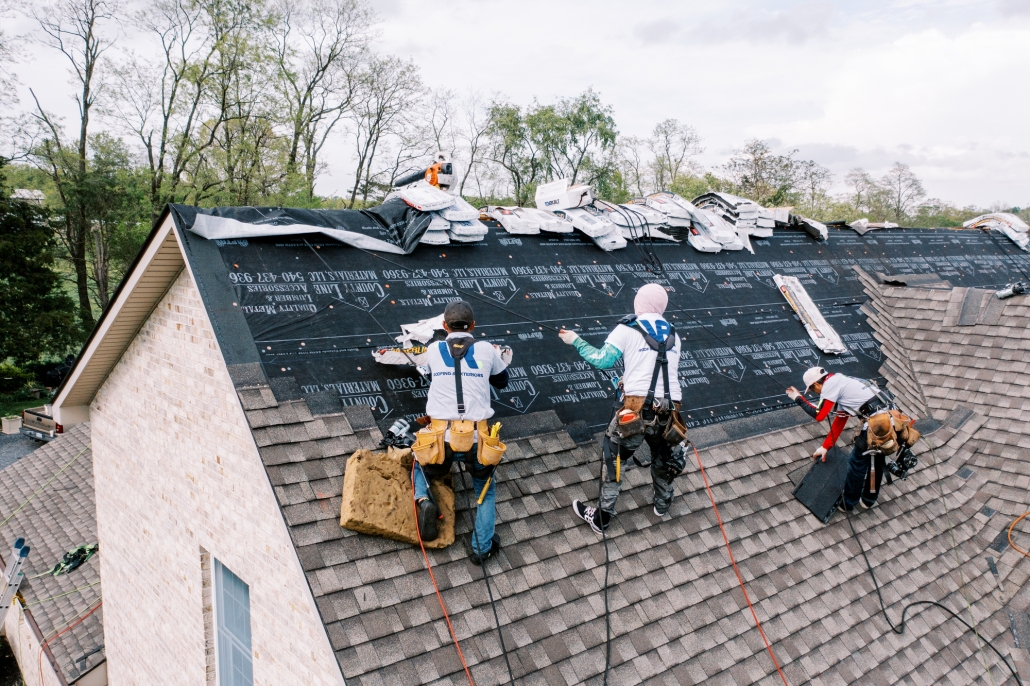A Comprehensive Look at Roofing Companies Gainesville Homeowners Recommend
A Comprehensive Look at Roofing Companies Gainesville Homeowners Recommend
Blog Article
Ideal Practices for Ensuring Proper Roof Covering Air Flow
Guaranteeing proper roof air flow is essential for the durability and performance of a roof covering system. A well balanced consumption and exhaust vent ratio, generally 1:300, plays an essential duty, with intake vents preferably positioned at the reduced edge of the roof covering for great air entry and exhaust vents at the peak for cozy air leave. Routine inspections to identify clogs and preserve clear air flow are paramount. Keeping insulation away from vents is crucial to prevent air flow restriction. Comprehending these foundational components establishes the phase for more detailed understandings right into installation and maintenance practices that can dramatically enhance your roof's performance.
Understand Air Flow Basics
Appropriately recognizing ventilation fundamentals is crucial for guaranteeing the durability and performance of roof. Efficient air flow mitigates dampness build-up and temperature level extremes in the attic room, both of which can cause considerable architectural damage with time. A well-ventilated roof covering helps in protecting against usual issues such as mold and mildew growth, timber rot, and ice dams, which can compromise the stability of the roof covering products and the underlying structures.
The key goal of air flow is to promote the activity of air, permitting a constant exchange between the exterior and interior atmospheres. This balance is attained with a combination of consumption and exhaust vents that collaborate to keep optimum air flow. Consumption vents, generally located along the soffits or eaves, allow fresh air to get in the attic room space, while exhaust vents, often positioned at or near the roof ridge, make it possible for hot, humid air to escape.
Key factors affecting the effectiveness of roofing system ventilation consist of correct placement, ample sizing, and guaranteeing that both consumption and exhaust vents are unblocked. Regular examination and maintenance are crucial to recognize potential obstructions, damages, or inadequacies in the ventilation system, thereby safeguarding the roofing system's efficiency and resilience.
Types of Roof Vents
Roof vents play a critical function in keeping efficient attic room air flow and, by expansion, the total health and wellness of the roof covering system. Different kinds of roofing vents are offered, each with one-of-a-kind advantages tailored to certain roofing demands.

Soffit vents are installed under the eaves and operate in tandem with roofing vents to ensure a well balanced consumption and exhaust system. By permitting cooler air to go into from below, soffit vents promote the expulsion of hot air through upper vents. Gable vents, situated on the exterior wall surfaces of the attic, deal another efficient remedy, particularly in homes with gable roofings.
Assess Your Present Air Flow

Next, consider the age and condition of your roofing materials and air flow parts. Older systems might not conform with current building ordinance or might have degraded over time, lowering their efficiency. Conduct a thorough exam to determine any type of indicators of deterioration, such as corrosion, damages, or spaces that can jeopardize the system's performance.
Furthermore, measure the attic temperature level and humidity degrees. High temperatures and humidity can suggest poor ventilation.
Setup Best Practices
Efficient find out installation of roof air flow systems is extremely important for ensuring ideal performance and durability. Proper installment begins with comprehending the certain ventilation requirements of the structure and the roof it covers. This involves computing the proper proportion of consumption to wear down vents, typically sticking to the 1:300 policy, which specifies one square foot of air flow for each 300 square feet of attic floor area.

The positioning of vents is similarly critical. Intake vents must be set up at the roof's lower side, usually in the soffits, to enable cool air to go into. Exhaust vents, on the various other hand, must be installed near or at the roof covering's top to facilitate the exit of warm, wet air. This produces a natural air movement that helps preserve temperature and dampness balance within the attic area.
Seal all air vent connections meticulously to avoid air leakages and possible water seepage. Usage high-quality materials and adhere to maker standards to ensure toughness and performance. In addition, incorporating ridge vents with baffles can considerably improve air movement efficiency by avoiding wind-driven rain and snow from going into the attic.
Ultimately, precise setup of roof covering air flow systems minimizes potential problems such as mold growth, ice dams, and architectural damage, guaranteeing the roofing's stability and the building's total wellness.
Routine Maintenance Tips
Uniformity in maintenance practices is fundamental to guaranteeing the lasting effectiveness of roof ventilation systems. Regular assessments are vital, ideally performed biannually-- in the spring and fall. Throughout these assessments, make sure that vents are without debris, nests, and various other obstructions that could restrain air flow. Look for any kind of indications of dampness build-up or mold, as these can indicate inappropriate air flow or leaks (roofing companies gainesville florida).
Cleaning up the vents is another crucial job. Utilize a soft brush or a vacuum to get rid of dirt and debris from consumption and exhaust vents. Beware not to harm the air vent screens or louvers during the procedure. In addition, check the attic space for any indicators of water damages, which might jeopardize the integrity of the roofing system.
Appropriate insulation is equally important. Make certain that attic room insulation does not block the vents, as this can seriously restrict air flow. If any kind of insulation has shifted or worked out, reposition or change it to maintain an efficient obstacle.
Finally, replace any damaged or missing parts quickly. Damaged vents, broken tiles, or shabby flashing can all add to poor air flow and must be addressed right away. view it now Normal maintenance guarantees that the roof ventilation system operates efficiently, consequently prolonging the life-span of the roofing itself.
Final Thought
Ensuring correct roof covering ventilation is paramount for preserving the performance and durability of a roof. Adherence to the 1:300 intake and exhaust air vent ratio, coupled with the strategic placement of vents, is essential. Normal biannual evaluations, debris cleansing, and ensuring insulation does not block air flow are critical techniques. Executing these best methods will foster a well-ventilated roof, thus reducing potential problems related to moisture buildup and excessive warm, ultimately extending the roofing's lifespan.
A balanced consumption and exhaust air vent ratio, frequently 1:300, plays a pivotal role, with intake vents preferably positioned at the lower edge of the roofing for awesome air entrance and exhaust vents at the optimal for cozy air departure. Consumption vents, generally located along the soffits or eaves, allow fresh air to go into the attic room room, while exhaust vents, usually positioned at or near the roof ridge, enable hot, damp air to escape.
Soffit vents are set up under the eaves and work in tandem with roof vents to make sure a balanced intake and exhaust system. By enabling cooler air to get in from below, next soffit vents assist in the expulsion of hot air via top vents. Adherence to the 1:300 intake and exhaust air vent proportion, paired with the calculated placement of vents, is important.
Report this page